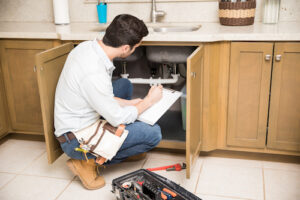
Today at Top Tier Plumbing and Rooter we want to provide you with the perfect checklist you can use to inspect your home’s plumbing and ensure that your plumbing is always up to par.
Plumbing issues can suddenly become so severe that they almost qualify as catastrophic. However, routine inspections of your essential plumbing fixtures can help you identify emerging issues and address them before they escalate into such emergencies.
Naturally, the bathroom and kitchen—rooms with the most plumbing fixtures—are the ones on which you should concentrate your inspection checklist. But don’t forget to look for other equipment and fittings throughout the house, from the hose spigots outside to the water heater in the utility room or basement.
Let’s start our checklist in one of the most important and used rooms in your home.
Bathrooms
Every family member uses the bathroom frequently, so it seems sensible that this area is most likely to experience plumbing issues.
Faucets: The bathroom faucets that require frequent maintenance are the sink, tub, and shower faucets. Regularly check them for leakage. To fix leaky faucets, swap out damaged washers or cartridges. Because such covert leaks can do significant damage before you notice them, water supply lines concealed in the walls for tub and shower drains can be a particular hazard. Water damage in the chamber below the plumbing pipes is a common symptom of hidden water pipe leaks. As you run the water, keep an eye on how the faucets function. If you observe low water pressure or an odd spray pattern, calcium buildup on the aerator may occur. Aerators may be physically removed and cleaned, or calcium accumulation may be eliminated by soaking in vinegar.
Drains: Bathroom sink, tub, and shower drains are prone to soap and hair clogs. Rather than waiting for these to obstruct the drain fully, you should routinely unclog the drain using boiling water or another homemade method, use a drain blocker, and remove hair and debris from the tub or drain blocker as soon as possible.
Toilets: Each of the several functional components of a toilet has the potential to wear out and create issues. Watch what occurs as you flush the toilet after removing the tank cover. Water is wasted significantly when a toilet doesn’t turn off once the flush cycle is complete. It’s frequently surprisingly simple to fix a running toilet. It is possible that the wax ring that seals the toilet base to the drain opening has worn out and needs to be changed if your toilet moves slightly when you sit on it or detect water seeping around its base.
Kitchen
The second most used room in a home, believe it or not, is your kitchen; your home’s kitchen is not only a place where tasty meals are prepared and where your whole family gathers to spend quality time together but also is another space with a lot of plumbing fittings in the kitchen. Check all the fixtures at least twice a year, and take care of any issues you find.
Sink Drains: The kitchen sink is frequently used, and leaking is frequently experienced in the sink strainer. As the water in the sink runs out, keep an eye on the P-trap and strainer region. When the strainer basket starts to leak or corrodes, the P-trap fittings might need to be tightened, and they should be replaced. A clog may be forming in the P-trap or branch drain of a sink that drains too slowly; these fittings can be taken apart and cleaned out. Periodically clean the drain in the kitchen sink. Running baking soda, vinegar, and water through your kitchen sink drain daily will aid in breaking up the normal accumulation there and keep the water flowing.
Faucets: The most frequent plumbing repair is a leaky kitchen faucet, which can quietly waste hundreds of gallons of water annually. As you pull the lever, pay close attention to your faucet and repair it if necessary.
Reversing valves: The fixture shutdown valves are designed to stop the flow of water when they are closed, controlling the water supply to the sink faucet, dishwasher, and refrigerator water lines. Close the valves firmly and verify they function as intended throughout your check. They must be replaced if they don’t stop the water flow entirely.
Disposal device: The drain connections where a dishwasher discharge links to the disposer and flows to the sink are where problems are discovered. If these points exhibit leakage, inspect them, tighten the connections, or replace the gaskets. A garbage disposal that smells bad and has to be cleaned. For regular garbage disposal maintenance, heed the manufacturer’s instructions.
Dishwasher: Take some time to observe and hear the dishwasher during your inspection tour. A sluggish filling dishwasher may have an issue with the water supply line or the shutoff valve that regulates it. If the dishwasher takes a while to drain or if there is drain water in the bottom of the dishwasher after the cycle is over, inspect the water discharge hose for clogs or pinching.
Around The Rest Of Your Home
The main plumbing components are the toilet, kitchen, and sewer system, but several additional fixtures and appliances also need to be regularly checked for issues; you should also check your irrigation system, washing machine, and outdoor hose spigots, and finally, your water heater.
Call The Experts
If you are experiencing a plumbing issue inside your home and need help fixing it, or if you would like a plumbing expert to help you inspect your home for possible plumbing issues, please dial (951) 475-6521 and speak to a Top Tier Plumbing and Rooter team member today.

